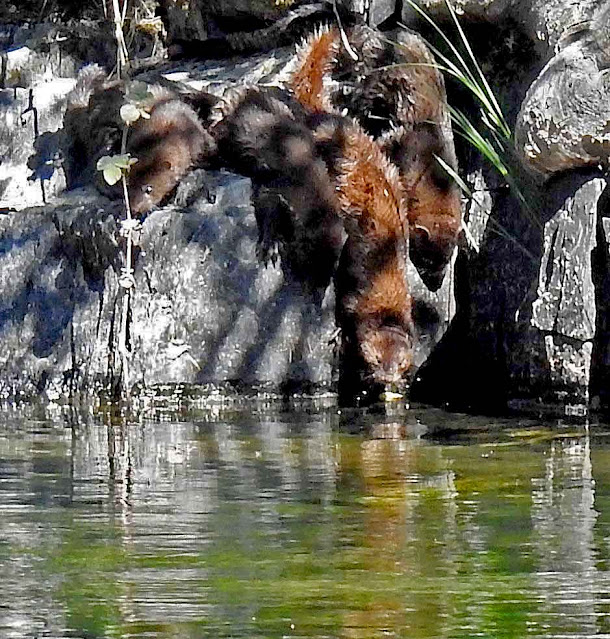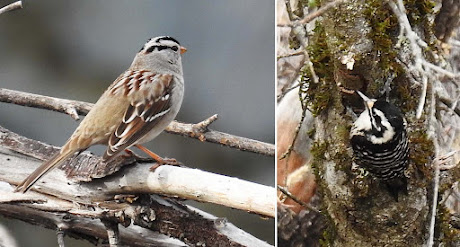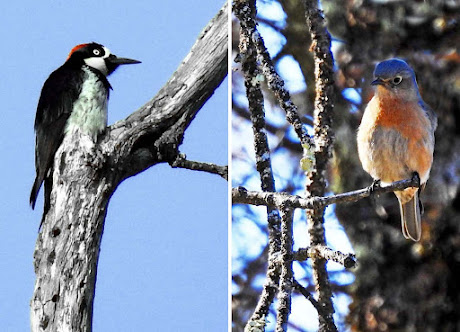Sandhill Cranes - Antigone canadensis
I've been wondering how scientists figure out how some birds and mammals mate for life. I've asked a few biologists how the studies are done, but haven't as yet got an answer back! I'm not having any luck searching the internet either, which is quite surprising! It's probably done by taking DNA samples of the parents and offspring. The question is, "How long do they take samples to determine if the species mates for life?" Hopefully I'll get an answer sometime soon! In the meantime, in the spirit of Valentine's Day, here is some info on the local species that uncommonly mate for life. As it turns out, most species don't!
Some birds mate for life such as Bald Eagles, Ospreys, Red-tailed Hawks, Tundra Swans, Sandhill Cranes, Snow Geese, Canada Geese, Barn Owls, Pileated Woodpeckers, and probably Common Ravens! The birds that tend to mate for life are large birds. Some scientist think that this is because large birds tend to have large territories to defend and it's better to not waste time on finding a new mate every year.
However, most birds only mate for one season or several seasons. There is monogomy (one mate in a season, eg. Goldfinches and most songbirds), polyandry (when a female has more than one mate in a season, eg. Spotted Sandpipers), and polygyny (when a male has more than one mate in a season, eg. Hummingbirds).
Common Ravens - Corvus corax
Scientists don't think "love" is an issue with birds, rather it's all about procreating and survival of the species. However, we non-scientific humans tend to see "caring" between birds and their mates. Are we projecting our emotions on wildlife? Probably! However, when I watched two Ravens allopreen each other it really seemed so gentle and loving to me! Who knows for sure? In the meantime, I am absolutely amazed that a Sandhill Crane can live up to 35 years in the wild, travel hundreds of miles annually in migration, and stay with the same mate the whole time! WOW!!!
Canada Geese with goslings - Branta canadensis
In a lot of bird species both parents help raise the young, such as the Canada Geese pictured above. In the case of our local ducks only the female cares for the young.
Common Merganser (female) and ducklings - Mergus merganser
Columbian Black-tailed Deer Doe and Fawns
Odocoileus hemionus columbianus
Motherly Love
Lifelong partnerships are rare in wild mammals. Of the roughly 5,000 species of mammals on the earth, only 3 to 5 percent are known to form lifelong pair bonds. Typically most mammals in our area (including Mule Deer, Black Bears, Mountain Lions, Raccoons, Skunks, Opossums, Ringtail Cats, and Squirrels) mate briefly, the male leaves, and the female raises the young.
After mating, female and male Columbian Black-tailed Deer go their separate ways. Only the female raises the young. Female fawns usually stay with their mothers for two years; young bucks leave after a year.
Columbian Black-tailed Deer Doe and Fawn
Odocoileus hemionus columbianus
American Mink female and three young - Neogale vison
Male and female American Minks only come together briefly to mate. The female raises their young. They remain with the mother through the summer until fall, when they leave to establish their own territories.
American Black Bear female and three cubs - Ursus americanus
American Black Bears only come together briefly with females to mate. The female raises the young. The cubs will stay with their mother through their second winter, until they are about 17 months old.
Gray Fox with a young Kit - Urocyon cinereoargenteus
Gray Foxes are an exception to the rule. Some websites state that Gray Foxes mate for life, others don’t. However, the male and female raise their kits together. Gray Fox kits will stay with their parents for approximately 10 months, and then disperse to find their own mates.
Gray Fox with Kit - Urocyon cinereoargenteus
I'll post the answer to my question about "mating for life" as soon as I get it!
In the meantime, Happy Valentine's Day!
View of the Sutter Buttes from the Darby Road Unit
The Daugherty Hill Wildlife Area is approximately 7,000 acres of rolling hills covered with blue and live oak, gray pine, and thick brush. There are four units and the approximate acreages are: Daugherty Hill (3,200 acres), Donovan Hill (1,800 acres), Quail Valley (1,300 acres), and Darby Road (700 acres). It is managed by the California Department of Fish and Wildlife.
This week we decided to check out the Darby Road Unit, which we had never been to before. All four units are very similar, with Blue Oaks, dry grassy slopes, shrubbery, and cows. This unit had a lovely, flat trail alongside a water ditch in the woods! No one else was there besides the cows and birds!
Yellow Chanterelle (?) - Turkey Tail (?)
Trametes versicolor - Cantharellus cibarius (?)
Surprisingly we came across what we thought were Yellow Chanterelles, and lots of tiny turkey-tail like fungi on the oak trunks! Most of the mushrooms in my neighborhood came and went about a month ago!
Cattle
As usual, there were cows grazing on the dry, grassy slopes. All of the units in the Daugherty Hill Complex were private ranches at one time. Through an arrangement with the Calif. Dept. of Fish and Wildlife, the land has become a nature preserve, but the cows are still allowed to graze. The following excerpt from ANR Publication 8517 at the University of Calif. Division of Agriculture and Natural Resources (located at http://anrcatalog.usan.edu) discusses the reasons why they have allowed the stock to remain.
"Because livestock grazing (primarily by cattle) can effectively reduce the biomass, height and thatch accumulation produced by non-native plants, it has become and essential tool for managing California's grasslands. Grazing has been shown to benefit California's annual grasslands in many ways - by reducing the risk of a catastrophic wildfire, maintaining and enhancing habitat for many native grassland plants and animals, and maintaining the open character of our iconic grasslands and oak savannas. Grazing can be managed to targets specific habitats, pest plants, fire hazards, and encroaching shrubs."
White-crowned Sparrow - Nuttall's Woodpecker (female)
Zonotrichia leucophrys - Dryobates nuttallii
We didn't see a lot of birds that day, maybe because it was gray, cold, and overcast. There were small flocks of White-crowned Sparrows near the pond, and we luckily saw a beautiful female Nuttall's Woodpecker in the woods.
Hooded Merganser (female) - Lophodytes cucullatus
There was a good-sized manmade pond in the unit! To our surprise there were Buffleheads and Hooded Mergansers in it, which unfortunately took off as soon as we approached.
Acorn Woodpecker (female) - Western Bluebird (male)
Melanerpes formicivorous - Sialia mexicana
We heard more Acorn Woodpeckers than we saw, and there weren't many Bluebirds out and about. In another month, when things warm up, they should both be more plentiful.
Mistletoe - Phoradendron spp.
The Black Oaks hadn't leafed out at all yet, so the only color in the winter woods were the clumps of mistletoe in the trees! Most of the berries are gone, which explains why we didn't see as many birds this time. It was a lovely day in an area we'd never been to before, and we'll be back again soon!
Weather Update!
We got 1.82" of rain last weekend, and the Lakes Basin got another 6" of snow! Yay! This brings our water year total to 52.52". A few small storms are predicted over the next 5 days, mainly rain. Luckily it's warmed up into the 30's and it isn't SO cold.
What's happening down in Spenceville?
Is Sardine Lake still frozen?
Check back next week for the answers to these questions and more!
Unfortunately, you can no longer sign up to get my blog via email. Just go to northyubanaturalist.blogspot.com directly.
Your questions and comments are greatly appreciated. Please feel free to email me at northyubanaturalist@gmail.com. Thanks!
.jpg)








altered.jpg)









No comments:
Post a Comment